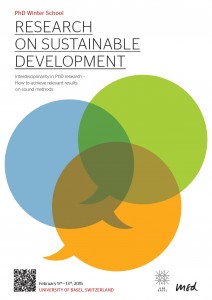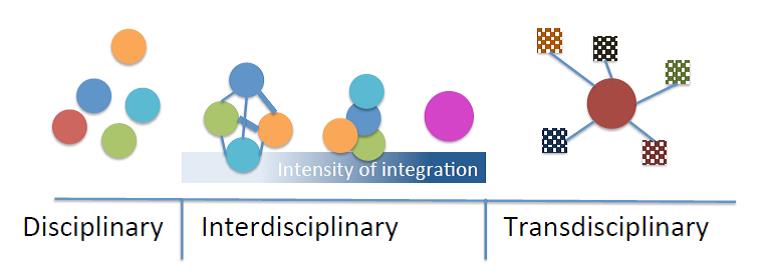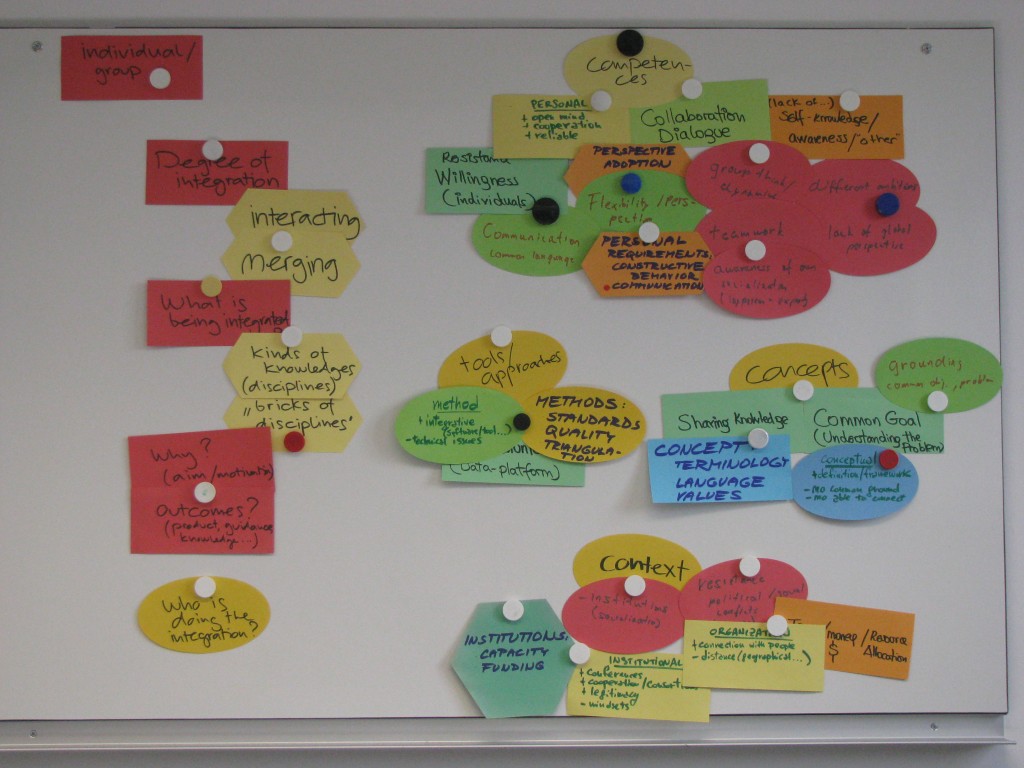Fish-WIKS News
» Go to news mainWhat is Interdisciplinarity
In February 2015 Mirjam Held, PhD student for the Nunavut region of the Fish-WIKS project, had the opportunity to attend a PhD Winter School on interdisciplinary research at the University of Basel in Switzerland. The week-long school focused on understanding interdisciplinarity, how to achieve relevant results on sound methods and hands-on group work within the framework of research on sustainable development. Here she shares a synopsis of the discussions about defining interdisciplinarity and interdisciplinary research.
 Interdisciplinarity is a term that is not easily understood as the scholarship of interdisciplinarity is characterized by a lack of a uniform terminology. In the strictest sense of the term, interdisciplinarityrefers to the combination of two (or more) disciplines to create a new discipline that is positioned between the parent disciplines and thus better able to address research situated at the overlapping boundaries of two disciplines. Examples of such inter-disciplines are biochemistry, geophysics and oceanography which, in the academic setting, are often at par with more traditional disciplines such as mathematics, biology or history.
Interdisciplinarity is a term that is not easily understood as the scholarship of interdisciplinarity is characterized by a lack of a uniform terminology. In the strictest sense of the term, interdisciplinarityrefers to the combination of two (or more) disciplines to create a new discipline that is positioned between the parent disciplines and thus better able to address research situated at the overlapping boundaries of two disciplines. Examples of such inter-disciplines are biochemistry, geophysics and oceanography which, in the academic setting, are often at par with more traditional disciplines such as mathematics, biology or history.
This inevitably raises the question of what is a discipline. According to Moti Nissani (1995), “a discipline can be conveniently defined as any comparatively self-contained and isolated domain of human experience which possesses its own community of experts”. As such, a discipline is a field of study that is characterized by a specific set of objectives, concepts, assumptions, principles and methodologies (Burger, 2015; Kockelmans, 1979). So far so good, but are these definitions helpful for a better understanding of what is interdisciplinarity?
Our modern concept of a discipline is based on historical distinctions that may now seem arbitrary as our knowledge within each discipline has multiplied over time. Thus, the current compartmentalization of our disciplines and inter-disciplines, be it in research, teaching or administration, is not satisfying (Kockelmans, 1979) and was indeed the cause for a great deal of discussion during the Winter School. The lack of a commonly used terminology has prompted numerous scholars to propose definitions, typologies and taxonomies of interdisciplinary endeavours.
Two prominent examples are the works of Joseph Kockelmans and Julie Klein. Kockelmans (1979) advocated for the use of the term interdisciplinarity in the narrow sense and proposed to distinguish between pluridisciplinary (when competence in one discipline presupposes a rather thorough knowledge of other disciplines), crossdisciplinary (employing insights and methods or techniques of some related disciplines, without attempting to integrate the disciplines) and transdisciplinary (systematically pursuing the problem of how the negative side effects of specialization can be overcome so as to make education and research more socially relevant) work for all other non-disciplinary activities.
Based on the first major interdisciplinary typology published by the Organization for Economic Co-operation and Development (OECD) in 1972 (Apostel, Berger, Briggs, & Michaud, 1972), Klein’s (2010) taxonomy of interdisciplinarity distinguishes, in a first step, multidisciplinarity (characterized by the juxtaposition of two or more disciplines), interdisciplinarity (characterized by disciplinary integration, interaction, linking and blending) and transdisciplinarity (characterized by transcending, transgressing and transforming the narrow scope of disciplinary worldviews). In a second step, the author distinguishes various forms of interdisciplinarity, depending on the degree of integration, interaction and collaboration (Klein, 2010).
On the other hand, the term interdisciplinarity is also used in the broad sense, i.e. referring to all non-disciplinary endeavours in research, education or administration (Kockelmans, 1979). One such broad definition of interdisciplinary research characterizes it as research of a common problem that concerns several disciplines, thus taking place at a “disciplinary interface” and establishing new knowledge by integrating different disciplinary perspectives (Brand, 2000; Godemann, 2006).
During the first afternoon of the PhD Winter School the participants and instructors discussed several examples of both the narrow-sense and broad-sense definitions of interdisciplinarity, but neither approach seemed to be helpful in coming up with a working definition that was to provide a common framework to guide us through the rest of the week. While disciplinary and transdisciplinary work is readily distinguished from interdisciplinary work, we had to accept the fact that interdisciplinarity is a continuum of different approaches to collaboration among two or more disciplines that is not easily defined. The figure below depicts the common denominator of our understanding of disciplinary, interdisciplinary and transdisciplinary work.
The continuum of interdisciplinarity. Reprinted from Presentation slides by M. Christen, 2015, University of Basel. Reprinted with permission.
After much debate we chose to take a rather pragmatic approach that focuses on the crucial element of integration in interdisciplinary research. Our comparative framework was organized along a number of questions we had devised to help us discern different degrees of disciplinary integration. Questions included: Who is doing the research? What is the degree of integration (from mere interaction to full merging)? What is being integrated (what kinds of knowledge, what disciplines, what elements of disciplines)? What is the motivation for interdisciplinarity? What are the outcomes? Who is doing the integration? What is the common conceptual basis? What tools or approaches are used?
A snapshot of the work-in-progress devising the questions that eventually organized our common framework for interdisciplinary research. Photograph by M. Held, 2015.
Throughout the rest of the week, the framework provided a valuable guiding tool to evaluate the interdisciplinarity of our own research as well as of the work presented by instructors and guest lecturers. Along the way, however, the framework experienced adaptations as not all questions proved equally relevant. Nevertheless, our structuring turned out to be well in line with Lattuca’s (2001) argument that disciplinary integration and interaction provide the most common framework to compare and understand different types of interdisciplinary work.
References
Apostel, L., Berger, G., Briggs, A., & Michaud, G. (Eds.) (1972). Interdisciplinarity: Problems of teaching and research in universities. Paris: Organization for Economic Co-operation and Development.
Brand, K.-W. (2000). Nachhaltigkeitsforschung: Besonderheiten, Probleme und Erfordernisse eines neuen Forschungstypus. In K.-W. Brand (Ed.), Nachhaltige Entwicklung und Transdisziplinarität: Besonderheiten, Probleme und Erfordernisse der Nachhaltigkeitsforschung(pp. 9-28). Berlin: Analytica Verlag
Burger, P. (2015). Science, knowledge production, and interdisciplinarity [Presentation slides]. PhD Winter School Research on Sustainable Development, University of Basel.
Christen, M. (2015). Introductory workshop: Interdisciplinarity and methods of interdisciplinary research [Presentation slides]. PhD Winter School Research on Sustainable Development, University of Basel.
Godemann, J. (2006). Promotion of interdisciplinary competence as a challenge for Higher Education. Journal of Social Science Education, 5(2), 51-61.
Klein, J. T. (2010). A taxonomy of interdisciplinarity. In R. Frodeman, J. T. Klein, C. Mitcham, & J. B. Holbrook (Eds.), The Oxford handbook of interdisciplinarity (pp. 15-30). Oxford: Oxford University Press.
Kockelmans, J. J. (1979). Why interdisciplinarity? In J. J. Kockelmans (Ed.), Interdisciplinarity and Higher Education (pp. 123-160). University Park and London: The Pennsylvania State University Press.
Latttuca, L. (2001). Creating interdisciplinarity: Interdisciplinary research and teaching among college and university faculty. Nashville: Vanderbilt University Press.
Nissani, M. (1995). Fruits, salads, and smoothies: A working definition of interdisciplinarity. Journal of Educational Thought, 29(2), 121-128.
Recent News
- Muiwatmnej Etuaptmumk Conference 2023 LiveStream
- Knowledge Pluralism in First Nations’ Salmon Management
- Learning Lodge on Mi’kmaw Livelihood Rights
- RoseAnne Archibald elected as national chief of Assembly of First Nations
- Mary Simon named as Canada’s first Indigenous governor general
- Mi'kmaw‑Led Conservation Webinar Series ‑ Thurs March 25 at 6 pm
- FishWIKS team members Lydia Ross and Lucia Fanning publish paper on informed management decision‑making
- FishWIKS team member Nicole LaTulippe co‑authors paper on need to make way for Indigenous research leadership


